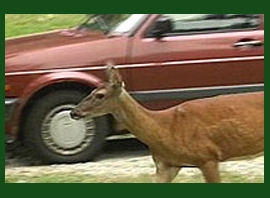* Be especially watchful at dawn and dusk when deer are most active;
* Deer seldom travel alone. If one crosses a road, others may follow;
* Slow down and be alert near wooded areas, water sources and green spaces, such as parks or golf courses;
* Don’t swerve to avoid hitting a deer. The most serious accidents happen when motorists take evasive action;
* Heed deer crossing sign warnings;
* Use bright lights and slow down when deer are spotted;
* If you hit a deer, pull onto the shoulder, turn on emergency flashers, and watch for traffic if you leave your vehicle;
* Don’t remove a deer from the roadway unless you are certain it’s dead – an injured deer can hurt you;
* Motorists can report a crash on a Kansas highway by dialing *47 (*HP) on a cell phone for a highway patrol dispatcher or *582 (*KTA) for assistance on the Kansas Turnpike, or by dialing 911;
* If a crash results in personal injury or damage of $1,000 or more, the driver is required to immediately report it to the nearest law enforcement agency. Failure to do so is a misdemeanor and could result in suspension of driving privileges;
* If you are involved in a non-injury crash on an interstate, U.S. highway or any divided or multi-lane road in Kansas and aren’t transporting hazardous materials, you are required by law to move your vehicle out of the lane of traffic;
* The best way to prevent serious injuries and death in a crash is to make sure all occupants are buckled up and children are secured in an appropriate child safety seat.
Source: Kansas Department of Transportation, Kansas Highway Patrol, Kansas Department of Wildlife and Parks

